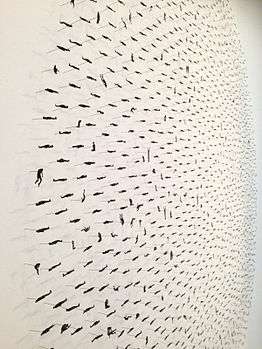Anita Groener
| Anita Groener | |
|---|---|
 Anita Groener, 2009 | |
| Born |
Anita Groener June 15, 1958 Veldhoven, The Netherlands |
| Nationality | Dutch |
| Education |
Mollerinstituut Moller Institute in Tilburg Hogeschool voor de Kunsten, Arnhem |
| Known for | Artist |
| Notable work | State (2013); Somewhere Else (2012); Crossing (2006) |
Anita Groener is a Dutch-born artist (born 1958, Veldhoven, The Netherlands) now based in Dublin, Ireland. She makes paintings, monumental site-specific drawings, film and animation which she exhibits internationally. Groener graduated in 1980 with a BA from the Mollerinstituut Moller Institute in Tilburg, the Netherlands. She received an MA from the Hogeschool voor de Kunsten, Arnhem, the Netherlands, in 1982, and moved to Dublin in the same year. In 2005 she was elected by her peers to be a member of Aosdána, the cultural body which recognises major, sustained contribution to the arts in Ireland.
Career

Groener is currently best known for her drawings and drawing-like paintings, sometimes with cut-outs pinned to a wall and often of very large scale. Groener's work over the last decade, 2005 – 2015, is simultaneously sparse and seemingly overpopulated. For example, of the eponymous artwork in her 2013 show State at the Royal Hibernian Academy (RHA), Dublin, art critic Cristín Leach Hughes wrote, "Nearly 2,000 tiny individuals are trapped, held with pins. Stand back and they form the population of a spotlit planet, a floating sphere that points to man's ultimate insignificance. Step forward and they argue for the intimate importance of our presence in the scheme of things."[1]
Groener also works with film and animation, as in video pieces in her Royal Hibernian Academy show Crossings in 2006, or her graphic animation Somewhere Else, shown in the Kilkenny Arts Festival in 2012.
In contrast to her later, more restrained pieces, those writing on early displays of Groener's work in Dublin were struck by the forceful imagery and execution, and greeted them as roughly belonging to the (New) Expressionist and possibly Cobra traditions (e.g., Fallon, 1986;[2] Kelly, 1988;[3] Dunne, 1989).[4] The link between earlier and later works can perhaps be found in large, largely monochromatic paintings such as Trajectory, 2004, or Crossing, 2006. These are gesturally expressive but more patterned than the earlier works, which tended to contain human- or animal-like elements which were proportionately more dominant.
Writers and critics tracked these changes in Groener's work. "Repetitive visual patterns and images evoke the repetitive patterns of human communication. Rather than diminishing the significance of such routine intercourse, the effect underlines the latent emotional charge of apparently banal exchanges. Behind the language of habit, there is a tacit awareness of separation and change, of loss and distance, of time passing."[5] Similarly, critic Mark Ewart wrote with respect to Groener's Heartlands show at the Rubicon Gallery, Dublin, "The first thing to hit you about these 28 paintings is, paradoxically, their sparsity."[6]
A leitmotif in Groener's work has been the psychological. Ciarán Benson (now Emeritus Professor of Psychology at University College Dublin), when writing about Crossings, concurred with Groener's visual imagery of road and journey to depict the evolution of the self (Benson, 2006).[7] "The lines are paths of experience" – Martí Peran on Groener's work (Peran, 2009).[8] Groener's approach resonates with Freudian or Lacanian theory (e.g., Kissane, 2009),[9] with works signalling the danger of losing the individual in the collective or the unknown, but with the same or related works pointing towards disconnect or disintegration at the level of the person. Patrick T. Murphy, Director of the RHA, writing about Groener's State at the RHA, puts it thus: "...the universal task of situating the self upon this earth. How do we figure ourselves within the societal, the geopolitical, the global?"[10]
Groener has stated about her development as an artist and her way of working, "I used to wonder what exactly art was for me. I've come to the conclusion that it is a physical manifestation of my thinking, of my experience of the world."[11]
Academic influence
After her move to Dublin, Groener appears to have found early, ready acceptance among her peers. She was elected to the committee of the Independent Artists in 1985, and the same year she was instrumental in bringing a show of 10 Dutch artists to Ireland.[12] She was one of only 120 artists, composers and a calligrapher included in The Great Book of Ireland published in 1991. Simultaneously Groener was having a significant impact on art teaching and practice. She began lecturing at the Dublin Institute of Technology (DIT) in the Department of Fine Art in 1982. She was Course Leader for Fine Art during two periods and was head of department from 2004 to 2006.[13] Groener left DIT to pursue her own practice in 2014.
References
- ↑ Leach Hughes, Cristín (2013-04-07). "Anita Groener – State". Sunday Times.
- ↑ Fallon, Brian (1986-06-06). "Anita Groener at". Irish Times.
- ↑ Kelly, Liam (1988-01-01). "Edge, Arts Council Gallery, Belfast, 7 Jan - 6 Feb 1988". Circa Art Magazine. Retrieved 2015-12-21.
- ↑ Dunne, Aidan (1989-02-12). "Matters of Symbolism". Sunday Tribune.
- ↑ Dunne, Aidan (2000-03-01). "Life and death in art". Irish Times. Retrieved 2015-12-07.
- ↑ Ewart, Mark (2000-04-15). "Anita Groener: Heartlands". Irish Times. Retrieved 2015-12-07.
- ↑ Benson, Ciarán (2006-06-01). "From Here to Where? Roads as Metaphors for Self & the Work of Anita Groener" (PDF). CROSSING 2006; published by Royal Hibernian Academy Dublin; ISBN 1-903875-29-3. Retrieved 2015-12-21.
- ↑ Peran, Martí (2009-06-06). "Against Landscape" (PDF). Living Landscape. Retrieved 2015-12-22.
- ↑ Kissane, Sean (2009-05-03). "Gilgamesh And The Uncanny" (PDF). Tipping Point. Retrieved 2015-12-22.
- ↑ Murphy, Patrick T. (2013-05-27). "About STATE" (PDF). STATE. Retrieved 2015-12-22.
- ↑ Dunne, Aidan (2006-01-30). "Journeys between departure and arrival". Irish Times.
- ↑ Frommé, Bob (1985-10-03). "Ontdekkingen en open deuren in Dublin". Het Parool.
- ↑ "Staff Articles - Staff Articles - Dublin School of Creative Arts". www.dit.ie. Retrieved 2015-10-09.